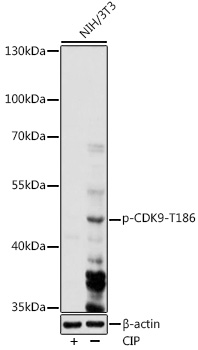Anti-Phospho-CDK9-T186 pAb Antibody (CABP0810)
- SKU:
- CABP0810
- Product type:
- Antibody
- Application:
- WB
- Reactivity:
- Human
- Reactivity:
- Mouse
- Reactivity:
- Rat
- Host Species:
- Rabbit
- Isotype:
- IgG
- Research Area:
- Epigenetics and Nuclear Signaling
Description
| 抗体名: | Anti-Phospho-CDK9-T186 Antibody |
| 抗体コード: | CABP0810 |
| 抗体サイズ: | 20uL, 50uL, 100uL |
| 申し込み: | WB |
| 反応性: | Human, Mouse, Rat |
| 宿主種: | Rabbit |
| 免疫原: | A synthetic phosphorylated peptide around T186 of human CDK9 (NP_001252.1). |
| 申し込み: | WB |
| 推奨希釈: | WB 1:500 - 1:2000 |
| 反応性: | Human, Mouse, Rat |
| ポジティブサンプル: | NIH/3T3 |
| 免疫原: | A synthetic phosphorylated peptide around T186 of human CDK9 (NP_001252.1). |
| 精製方法: | Affinity purification |
| ストレージバッファ: | Store at -20°C. Avoid freeze / thaw cycles. Buffer: PBS with 0.02% sodium azide, 50% glycerol, pH7.3. |
| アイソタイプ: | IgG |
| 順序: | RYTN R |
| 遺伝子ID: | 1025 |
| Uniprot: | P50750 |
| セルラーロケーション: | Cytoplasm, Nucleus, PML body |
| 計算された分子量: | 42kDa/53kDa |
| 観察された分子量: | 43KDa |
| 同義語: | CDK9, C-2k, CDC2L4, CTK1, PITALRE, TAK |
| バックグラウンド: | The protein encoded by this gene is a member of the cyclin-dependent protein kinase (CDK) family. CDK family members are highly similar to the gene products of S. cerevisiae cdc28, and S. pombe cdc2, and known as important cell cycle regulators. This kinase was found to be a component of the multiprotein complex TAK/P-TEFb, which is an elongation factor for RNA polymerase II-directed transcription and functions by phosphorylating the C-terminal domain of the largest subunit of RNA polymerase II. This protein forms a complex with and is regulated by its regulatory subunit cyclin T or cyclin K. HIV-1 Tat protein was found to interact with this protein and cyclin T, which suggested a possible involvement of this protein in AIDS. |
| UniProt Protein Function: | CDK9: a protein kinase of the CDK family. Forms a complex with and is regulated by its regulatory subunit cyclin T or cyclin K. A component of the multiprotein complex TAK/P-TEFb, which is an elongation factor for RNA polymerase II-directed transcription and functions by phosphorylating the C-terminal domain of the largest subunit of RNA polymerase II. Transcriptional elongation factor and cofactor for HIV Tat protein; RNAi blocks HIV replication, and inhibitors also block varicella zoster replication. Mediates signals leading to cardiac hypertrophy. Inhibitor: Flavopiridol. |
| UniProt Protein Details: | Protein type:Kinase, protein; Cell cycle regulation; Nuclear receptor co-regulator; EC 2.7.11.22; EC 2.7.11.23; Protein kinase, CMGC; Protein kinase, Ser/Thr (non-receptor); CMGC group; CDK family; CDK9 subfamily; CDK/CDK9 subfamily Chromosomal Location of Human Ortholog: 9q34.1 Cellular Component: nucleoplasm; transcription elongation factor complex; PML body; transcription elongation factor complex b; intracellular membrane-bound organelle; membrane; cytoplasm Molecular Function:RNA polymerase subunit kinase activity; protein binding; snRNA binding; DNA binding; cyclin-dependent protein kinase activity; chromatin binding; ATP binding; protein kinase activity Biological Process: regulation of histone modification; transcription from RNA polymerase II promoter; transcription initiation from RNA polymerase II promoter; positive regulation of histone phosphorylation; transcription, DNA-dependent; viral reproduction; positive regulation of viral transcription; regulation of mitotic cell cycle; DNA repair; protein amino acid phosphorylation; regulation of DNA repair; cell proliferation; transforming growth factor beta receptor signaling pathway; RNA elongation from RNA polymerase II promoter; replication fork arrest; gene expression; positive regulation of transcription from RNA polymerase II promoter |
| NCBI Summary: | The protein encoded by this gene is a member of the cyclin-dependent protein kinase (CDK) family. CDK family members are highly similar to the gene products of S. cerevisiae cdc28, and S. pombe cdc2, and known as important cell cycle regulators. This kinase was found to be a component of the multiprotein complex TAK/P-TEFb, which is an elongation factor for RNA polymerase II-directed transcription and functions by phosphorylating the C-terminal domain of the largest subunit of RNA polymerase II. This protein forms a complex with and is regulated by its regulatory subunit cyclin T or cyclin K. HIV-1 Tat protein was found to interact with this protein and cyclin T, which suggested a possible involvement of this protein in AIDS. [provided by RefSeq, Jul 2008] |
| UniProt Code: | P50750 |
| NCBI GenInfo Identifier: | 68067660 |
| NCBI Gene ID: | 1025 |
| NCBI Accession: | P50750.3 |
| UniProt Secondary Accession: | P50750,Q5JU24, Q5JU25, Q5U006, Q96TF1, |
| UniProt Related Accession: | P50750 |
| Molecular Weight: | 372 |
| NCBI Full Name: | Cyclin-dependent kinase 9 |
| NCBI Synonym Full Names: | cyclin-dependent kinase 9 |
| NCBI Official Symbol: | CDK9 |
| NCBI Official Synonym Symbols: | TAK; C-2k; CTK1; CDC2L4; PITALRE |
| NCBI Protein Information: | cyclin-dependent kinase 9; CDC2-related kinase; cell division protein kinase 9; serine/threonine protein kinase PITALRE; cell division cycle 2-like protein kinase 4; tat-associated kinase complex catalytic subunit |
| UniProt Protein Name: | Cyclin-dependent kinase 9 |
| UniProt Synonym Protein Names: | C-2K; Cell division cycle 2-like protein kinase 4; Cell division protein kinase 9; Serine/threonine-protein kinase PITALRE; Tat-associated kinase complex catalytic subunit |
| Protein Family: | Cyclin-dependent kinase |
| UniProt Gene Name: | CDK9 |
| UniProt Entry Name: | CDK9_HUMAN |


